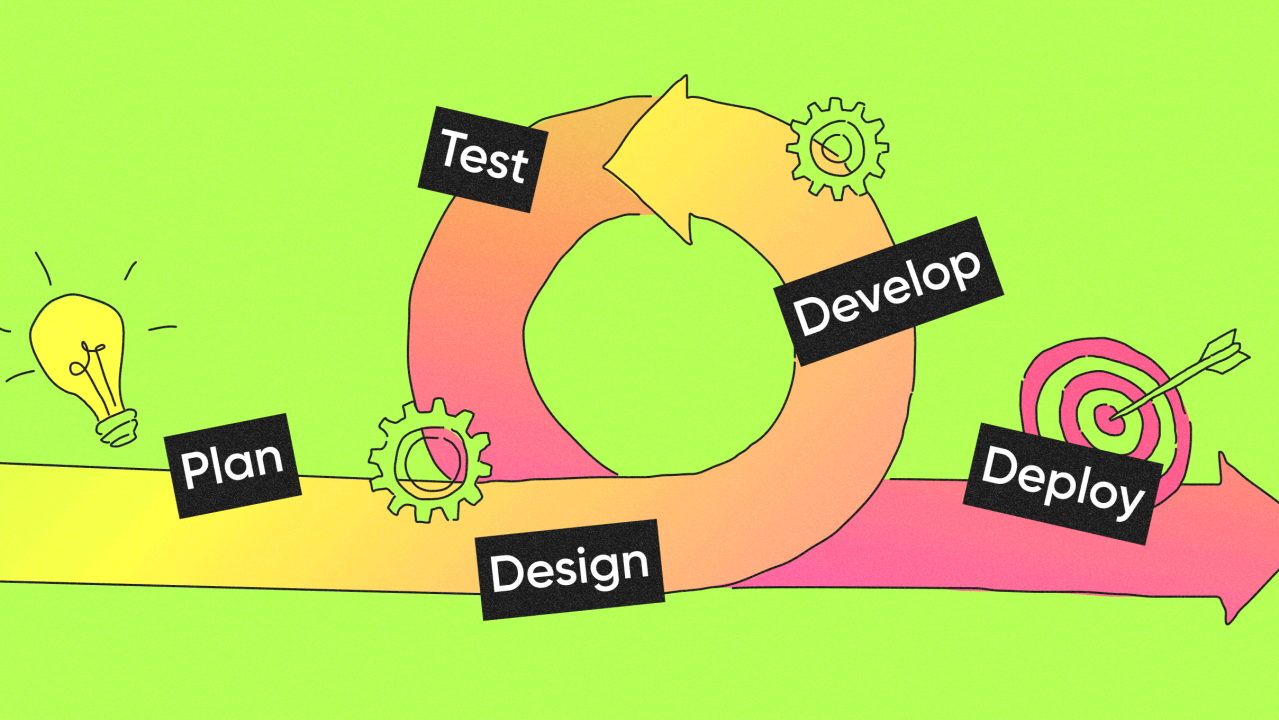
Most Commonly used Software Development Methodologies
Software Development Methodologies
Software development is the process of creating, testing, and maintaining software products and services that meet user, customer, or stakeholder expectations. Software development methodologies are frameworks or models that guide the software development process and define the roles, responsibilities, activities, and deliverables of the software development team.
There are lots of different software development methodologies present, and each of them has its own advantages and disadvantages. In this article, we will discuss the five most commonly used software development methodologies: Agile, Scrum, Waterfall, Kanban, and DevOps.
- Agile
- Scrum
- Waterfall
- Kanban
- DevOps
Agile
In English, Agile means ‘the ability to move quickly and easily’ and respond to change rapidly – this is an important aspect of Agile software development. Agile Software Development is a software development methodology that values flexibility, collaboration, and customer satisfaction. The Agile Model was primarily designed to help a project adapt quickly to change requests. So, the main aim of the Agile model is to facilitate quick project completion.
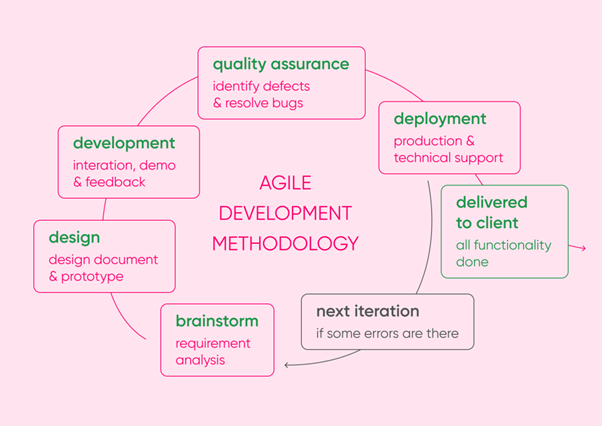
Agile development methodology
Pros:
- It provides faster delivery of software products and features.
- Agile methodologies prioritize customer satisfaction.
- In Agile methodology, daily interactions are required between the business people and the developers.
- Changes in the requirements are accepted even in the later stages of the development.
- Better adaptation to rapidly changing requirements and respond faster.
- Documentation is valued, but the priority is on creating working software and delivering value to the end users rather than generating extensive documentation.
Cons:
- Agile development models require a high degree of expertise from team members.
- The agile model is not suitable for larger and complex projects.
- For complex projects, the resource requirements and effort are difficult to estimate.
- Sometimes in Agile methodology, the requirement is not very clear, hence it’s difficult to predict the expected result.
Suitable for
Agile software development is suitable for projects that require flexibility and continuous improvement. It is best for projects with changing requirements, where the ability to adapt quickly is essential. It’s also ideal for projects that involve innovation and experimentation. In terms of team size, Agile is effective for small to medium-sized teams that can collaborate closely and make decisions quickly.
However, Agile may not be the best fit for projects with a lack of collaboration and communication. It may not work for large projects that demand a rigid structure and a lot of documentation. This method is also not suitable for projects with insufficient participation of the product owner, where it’s impossible to reach them to get feedback, or they simply don’t have time for it.
Scrum
Scrum is a lightweight framework for agile development. It is subset of Agile Software development process which is nothing but an iterative and incremental software development technology. Scrum divides the software development process into fixed-length iterations called sprints, which typically last from one to four weeks.
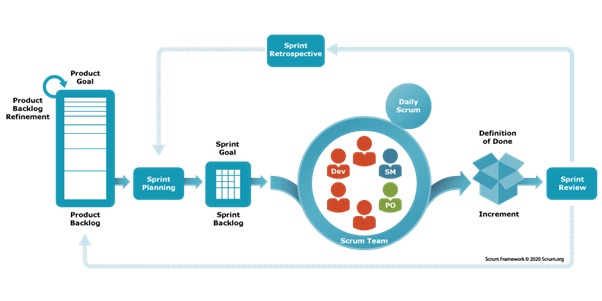
Scrum development methodology
Each sprint consists of four phases:
- Sprint planning: In this stage, the Product Owner defines a goal for the sprint at the start of the sprint.
- Daily Scrum Meeting: The Scrum team gathers together in a meeting for around 15 minutes. They specify the progress report and roadblocks.
- Sprint Review: In this stage, the team demonstrates that what is ready for delivery to the customers. A meeting is conducted between the customer, product owner, and the Scrum Team.
- Sprint Retrospective: In this stage, Feedback is taken about how the team worked in the last sprint. and what action needs to be taken for improvement.
Pros:
- Scrum provides a framework for managing complex projects.
- In Scrum, customer satisfaction is very important.
- Through iterative development and frequent feedback, Scrum focuses on delivering value to the customer.
- Good for dynamic projects because of adaptability to changing requirements.
Cons:
- Frequent meetings in Scrum sometimes become time-consuming and impact productivity.
- Scrum framework does not allow changes to their sprint.
- Not good for projects like those with highly predictable and well-defined requirements.
Waterfall
Waterfall is one most traditional software development methodology that follows incremental and sequential approach. In waterfall there are at least 6 phase of development. the six phase are requirements analysis, design, implementation, testing, deployment, and maintenance. And most important things is each phase is completed before moving to next phase, and no change or revision are done once a phase is completed.
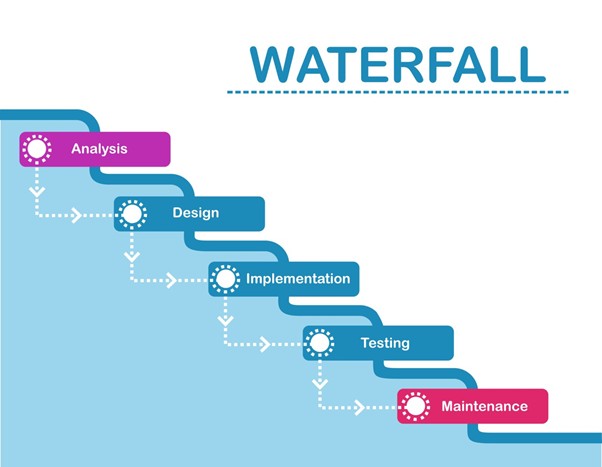
Waterfall development methodology
Pros:
- Waterfall Model is very simple and easy to understand.
- Waterfall Model works well for smaller projects and projects where requirements are well understood.
- In each phase detailed documentation is required.
- Phases in the Waterfall model are processed one at a time.
Cons:
- It is not well-suited where requirement are continuously changing and updating.
- Also there is no error detection or feedback present in each stage.
- Waterfall Model is not well-suited for complex projects.
- Waterfall Model can result in a lengthy development cycle, as each phase must be completed before moving on to the next. This can result in delays and increased costs if requirements change or new issues arise.
- There is no collaboration and innovation among different team members.
Kanban
Kanban is an The effective way to manage projects and make your workflow even better. The term “Kanban” originates from the Japanese language, translating to “visual signal” or “card.” Basically, you use a board with columns that show the different stages of your plan, and you use cards to represent tasks or features. The board is divided into sections like “To Do,” “In Progress,” “In Review,” and “Done.” It’s easy to understand and helps to keep track of everything. and also helps the teams to monitor and control at each stage and apply changes to improve efficiency.
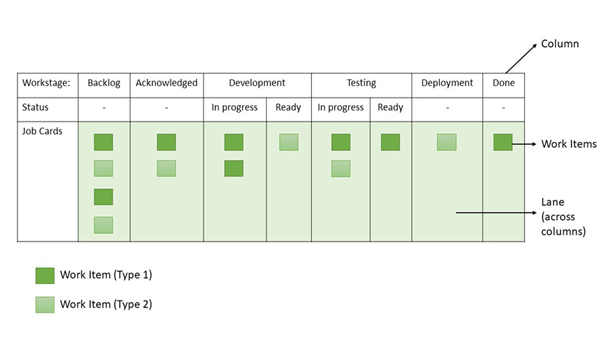
Kanban development methodology
Pros:
- Kanban is easy to implement and understand
- Use transparency to drive process improvement.
- Allows for quick reprioritization in order to adapt changes according to market demand.
- Limiting Work in Progress and setting policies will result in a better focus on quality and, as a result, increased customer satisfaction.
- Prioritization helps in streamlining processes and workflow to enhanced quality of work
Cons:
- When multiple team are involved managing complex project is very difficult through Kanban boards.
- Kanban may not ensure timely release or completion of tasks or features.
- Kanban doesn’t provide a fixed time frame for tasks or feature.
- The lack of defined roles and responsibilities in Kanban may result in inconsistent practices across teams.
DevOps
DevOps is basically a combination of two words- Development and Operations. which promotes collaboration between development and operations teams, resulting in better communication, increased efficiency, and faster delivery of the new products and frequent updates. The goal of DevOps is to increase an organization’s speed when it comes to delivering applications and services.
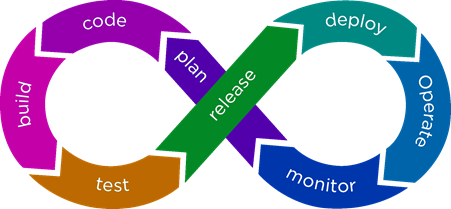
DevOps development methodology
Pros:
- DevOps helps organization for faster delivery of new product and updates faster and more frequently.
- DevOps provide better resource utilization.
- DevOps provide customer satisfaction as the releases and update are too frequent.
- DevOps promotes collaboration between development and operations teams, resulting in better communication, increased efficiency, and reduced friction.
Cons:
- Sometimes implementing DevOps can be costly process.
- Finding a qualified DevOps person is very challenging.
- DevOps is still a relatively new field, and there is a lack of standardization in terms of methodologies, tools, and processes.
Summary
In this article, we discussed some different software development methodologies, each with its own unique approach to guiding the software development processes. Each methodology is project-specific and has its own set of pros and cons. The choice of methodology depends on the project’s requirements and constraints.
No matter which methodology your team chooses, the software development life cycle will remain approximately the same.